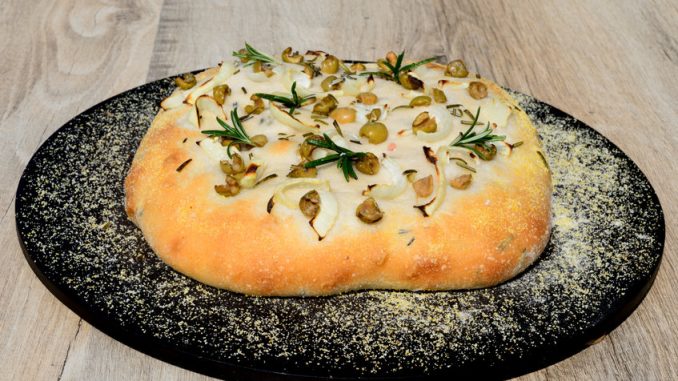
Foccacia is a particular favourite of mine. It tastes as if the Italian sun has entered the kitchen and is blazing away in all its glory with what is a pizza bread on the table. It’s very ancient too and lends itself to gustatory versatility with a range of flavourings judiciously based around dried herbs and olives. More adventurous bakers like to add vegetables as toppings. What can be more flavoursome than a few roasted tomatoes baked into the dough structure.
The origins go back to its name of hearth bread which in latin is panis focacius. You can see where the ‘foccacia’ derivative comes from now!
If you want a foccacia sandwich simply make a thicker structure in a deeper tray and slice down the middle. It lends itself well to meat and other fillings like cheese.
The timings are roughly 30 minutes for the preparation, 1.5 hours for proving at room temperature. It’s about 35 minutes in total for baking and preparation.
Ingredients For Foccacia:
- 500 g (1lb 2oz or 3½ cups) strong white flour, plus extra to dust. You could use Tipo ’00’ which is the Italian pasta flour
- 7 g sachet fast-action dried yeast
- 100 ml (3 ½ fl oz) extra virgin olive oil, plus extra to grease
- 25 ml (1 fl. oz.) extra virgin olive oil
- 1 teaspoon sea salt flakes or coarse crystals
Flavourings
- 2 rosemary sprigs, leaves picked for the flavouring. Some can also be chopped – it’s just a matter of taste.
- dried oregano and marjoram
- fennel seeds
- herbes de Provence
Preparation:
- Put the flour into a large bowl of a freestanding mixer fitted with a dough hook. Mix in yeast and 2 teasp. of fine salt.
- Add oil and 300ml (1/2 pint) lukewarm water and mix until all the flour is incorporated. Put the mixer hook on a slow-medium speed for 5min or until the dough is elastic and soft. The dough is surprisingly sticky so add a little more flour if it is too sticky).
- Cover the bowl with clingfilm and leave in a warm place to rise until it doubles in size after which is about 1.5hrs. The dough can also be placed in the refrigerator where it will rise but after 24 to 48 hours. Seems daft but it does happen!
- Dust a large baking tray with polenta or rice flour, or grease with olive oil.
- Collect up the dough and place on a prepared baking tray. Using fingers, press into a rough 20.5 x 30.5cm (8 x 12in) rectangle. The dough need not completely fill the sides as it will swell up during baking and fill the tray.
- Cover with greased clingfilm with the oil-side down and leave to prove in a warm place for 30 to 40 minutes until soft and squidgy.
- Preheat oven to 220°C (200°C fan) mark 7.
- In a small bowl, whisk together the topping oil with 25ml (1fl oz) water until emulsified. With floured fingers, poke vertical dimples into the dough so that they almost touch the tray. Drizzle over the oil mixture and scatter over salt flakes, rosemary and any other dried flavourings. In some cases whole olives can be added to fill the holes which adds a wholly Italian touch.
- Bake in the oven for 25 minutes or until it is a toffee-like golden brown. Some bakes like to rotate the tray half way through baking time to get an even colour but this seems a tad too fussy.
- Transfer to a wire rack to cool a little. Eat warm or at room temperature.
- Focaccia loses its springy texture after a day so it needs to be wrapped tightly in cling film if it is to retain any texture. It also makes very good croutons for a soup too.


Leave a Reply